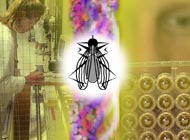Swiss scientists help to open the book of life

The mapping of the human genome - the genetic code which acts as a blueprint for the building of a human being - has been completed. Swiss scientists took part in the 10-year project which has revealed that far fewer genes are needed to create a human than was originally thought.
The most startling discovery of the mapping of the human genome is just how few genes are needed to “describe” a human being – around 30,000, as opposed to the 140,000 scientists had predicted.
The genome reveals how closely related we are to other species. We share about half our genes with the fruit fly, and about a fifth with yeast. Scientists believe that the key to the differences between humans and other species is the functions of a small number of genes and the proteins they control.
Scientists also found that the genetic code was strikingly similar across all ethnic groups, with all humans sharing 99.99 per cent of their genes. That means differences between humans of any race are defined by fewer than 300,000 “letters” in a three billion-letter sequence.
Swiss scientists were involved in sequencing the genes on chromosome 21, which represents one per cent of the genome. Team leader, Stylianos Antonarakis of the Division of Genetics at the University of Geneva Medical School, told swissinfo that the mapping of the genome was hugely significant.
“This is the most important discovery in human biology in the past 20 years. Now we know the infrastructure of our genome – we know the majority of our genes. That’s extremely important because once we identify the function of these genes, we can find which genes cause people to be pre-disposed to genetic disorders.
“Once we find these, we can develop therapies to treat a long list of human disorders from diabetes to Alzheimer’s disease. There’s a very long list of common human illnesses which have genetic causes.”
Another surprise from the genome was that many of our genes appear to have come from bacteria. That suggest that these creatures entered into symbiotic relationships with our ancestors and were ultimately absorbed into them.
The mapping of the genome was undertaken by two bodies – one an international consortium funded with public money, the other a private firm – Celera Genomics, based in the United States.
swissinfo with agencies

In compliance with the JTI standards
More: SWI swissinfo.ch certified by the Journalism Trust Initiative
You can find an overview of ongoing debates with our journalists here . Please join us!
If you want to start a conversation about a topic raised in this article or want to report factual errors, email us at english@swissinfo.ch.